 |
Churches in North Oxfordshire & Northamptonshire (the Bristol perspective!) or ChurchCrawling's Sixth Birthday11th June 2005 |
 |
Churches in North Oxfordshire & Northamptonshire (the Bristol perspective!) or ChurchCrawling's Sixth Birthday11th June 2005 |
The day began well, I slept soundly until 0640 when I sprang out of bed and hit the shower....... even managed a boiled egg shortly after seven as I anticipated the day to come. Starting the car I realised that I had forgotten to fill up with diesel so had a swift detour to Morrisons to fill up. Blue sky patches outnumbered white fluffiness and all seemed set fair. The day was set around dd's locking maps, with target churches being "blue dots" and open to visitors (we hoped). For the first AGM ever I did not use a single inch of motorway, and with iPod broadcasting to my car radio another first. The spire of Tetbury soared to heaven, the exuberance of Cirencester reflected the sunshine in its honey coloured stone, Burford Witney and Bladon went by and suddenly I realised it was only 0920 and Bicester was only eight miles away. Time for a stop, a selfish visit...
ST MARY, KIRTLINGTON, OXON (N.B. Oxon is standard UK abbreviation for Oxfordshire)
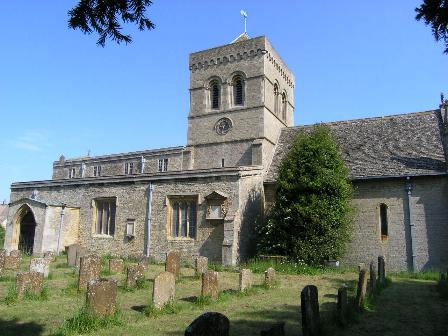 |
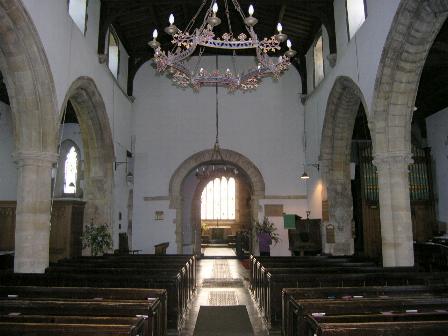 |
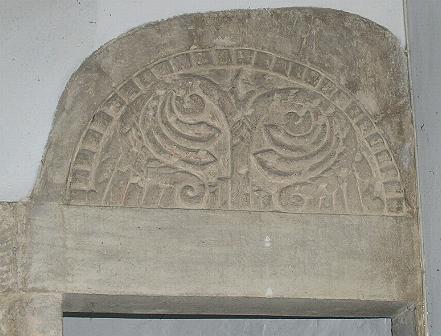 |
This was a scene-setter for most of the churches we were to see today. No overall style, a church grown from a core C12 crossing, with C13 nave and aisles, heightened with a clerestory in the C15. The church has a NeoNorman central tower and a chancel "faithfully rebuilt" by Scott. Inside much of interest including a large fragmentary wall painting in the north aisle, a reset Tree of Life tympanum by the crossing and some exquisite C18 gates shutting of the south transept with its large memorial to a member of the Dashwood family. | 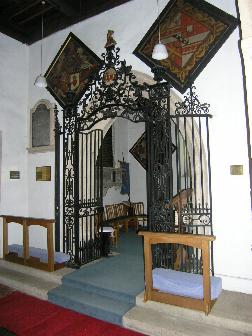 |
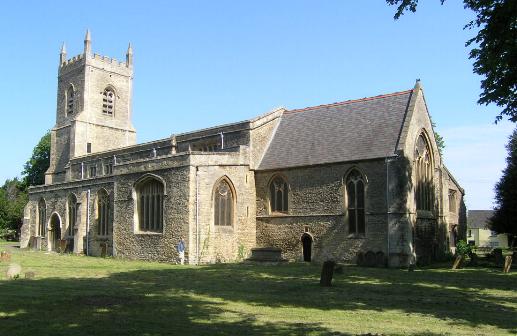 |
ST EDBURG BICESTER OXON |
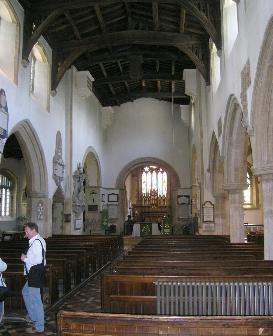 |
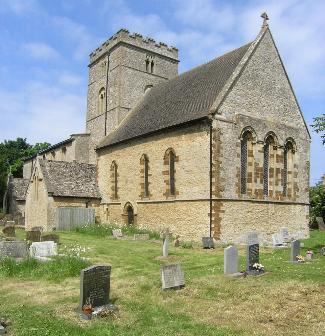 |
ST PETER, BUCKNELL, OXON has a C12 central tower with a large rounded stair turret in the NW angle. The rest was rebuilt in the C13 in an uncommonly handsome and ornate style. Very large buttresses support the alarmingly-leaning chancel north wall. The entrance is via the south porch through an ornate Early English doorway. From inside came the sound of organ music, some poor chap had chosen to have a quiet practice by himself and was now invaded by us lot! He was a game fellow and continued playing throughout our visit! Today it seems the chancel is all the church this village needs and the crossing is enclosed by a rather tasteless but practical glazed screen with doors. |
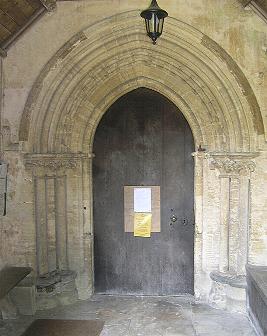 |
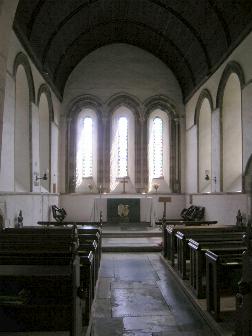 |
The seemingly Norman arches in the side walls immediately to the west of the crossing, blocked and with two-light C14 style windows, came in for some debate. BoE suggests they may have led to transepts - an odd position for them if so. Yet to me they looked C17 or C18 and the windows C19, but the moulding around the nave arched up over then and looks original. On top of the nave a C15 clerestory, despite there being no aisles. Some grand monuments in the nave - all to Trotmans, but one is more unusual including a cute cherub holding a weighty crested scroll for the inscription to Thomas T d 1751 and his son Samuel d 1775, erected by Fiennes T in 1777. | 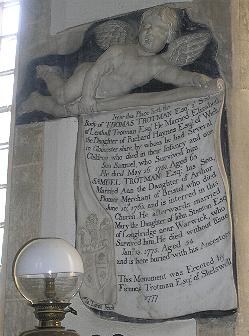 |
By now we had got this convoy driving off to a fine art, and it seemed my suggested route hastily prepared the night before was being followed by the group.
ST PETER, STOKE LYNE, OXON
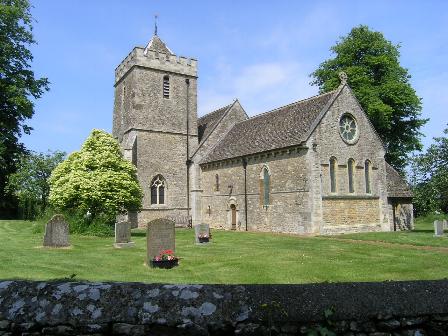 |
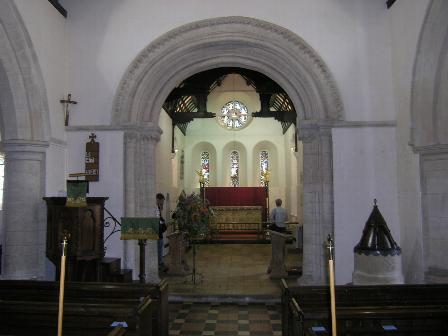 |
St Peter's church is basically a small norman church with a large C14 south tower, a C19 east end and a very late C20 "aisle" on the north side linked up to the surviving east bay of the original C13 aisle, a job well done - or it will be when the new stone weathers down to a less "bright and new" appearance. The impressive norman entrance has a large niche above which contains a damaged figure of St Peter.
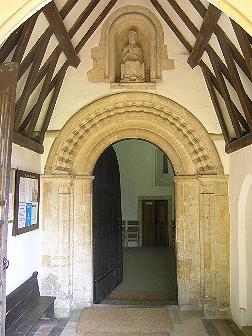 |
The most entertaining features inside were Victorian - a bad font with a conical font cover, the latter with awkward continuous Norman arcading, and the paired "hammer-beam" dragons with metal tie-beams issuing from their mouths, with the latter having prominent white teeth!! Also a strange stone figure occupied the sill of the now blocked west window of the NE bay of the aisle. The new extension certainly contained a toilet, as Diane knows! More awesome were the two brasses in the chancel, one with an unusual depiction of Resurrection of Christ, and the other in a recess above a tomb chest with strapwork and a large crest in the wall above. It was two churches later that I remembered having opening the porch doors wide to take a pic of the doorway. I hope the lady who swept into the church looking embarassed in taking away a large dead floral display (which features in many of our pictures!) or her two male helpers who came in a few minutes later to sweep up the dead petals and leaves on the floor spotted it and closed them (with no bad grace!) | 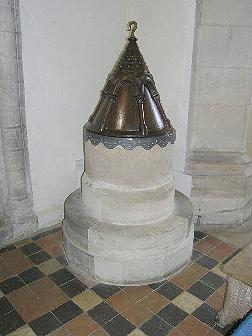 |
ST GEORGE, EVENLEY, NORTHANTS
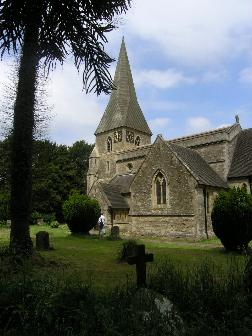 |
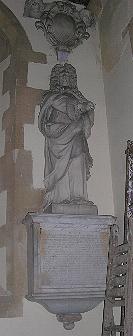 |
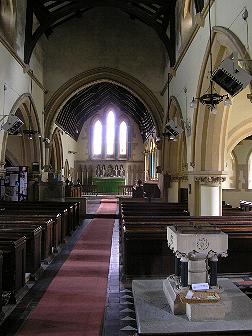 |
is a Victorian rebuilding by Henry Woodyer 1864-65, with some Hardman glass - well deduced by the group as Woodyer's signature a close-set row of narrow single-light windows gave the game away, but how John H recognises the glass so well is a mystery to me! Probably most people's least favourite church of the day, a dark and gloomy interior (the light augmented on the computer) a disappointment after the promising exterior. Skied in the tower is the surviving standing figure of the be-wigged Sir Creswell Levinz d1700, part of a presumably once-larger memorial. I have had a picture of this church in my "mystery" folder for some time, so the trip solved another one of these, although I had not posted this pic to the website.
HOLY TRINITY HINTON-IN-THE-HEDGES, NORTHANTS
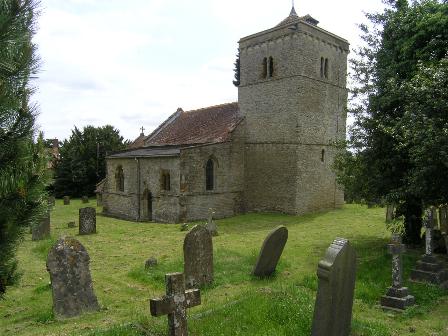 |
We missed the small pathway up from the village to the church and parked in a handy lay-by by a playing field and walked through to the church from here. Actually we filled the small car park, and discovered that some locals had returned and been unable to park without blocking another local in! An ancient and leaning C12 west tower, the rest of the church looking rather uninteresting outside and in a mixture of styles. Rushing in and you could miss the rather pretty incised graffiti-like decoration on the jambs of the doorway. |
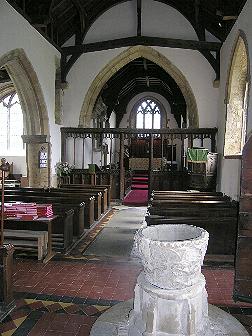 |
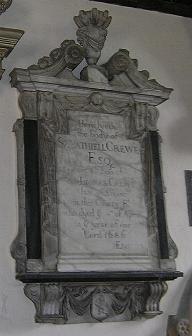 |
Much of interest inside the rather ordinary church; two C14 effigies of a knight and his lady lie along the north aisle wall, large Royal Arms of Queen Anne 1707 also in the north aisle, a medieval screen, a Jacobean pulpit and two small pieces of late C14 Stained Glass of a King and Queen in the south window of the sanctuary. Some fairly ordinary C17 and C18 memorials, including one to the surprisingly named Salathiell Crewe d1686 (left). | 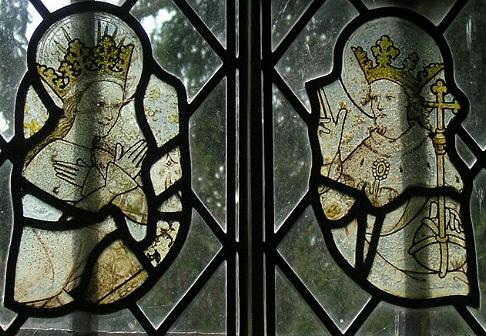 |
Hunger began to affect the group but the Crewe Arms in the village did not do food. We decided to proceed to the Marston Inn in the village of the same name. JV and JW took off fast..........the rest followed me along road to Farthingstone, with ever decreasing metalling (tarmac), more and more potholes, an increasingly large amount of central vegetation and ultimately a gate across the road! Oh how we laughed about this route later, mystifying the Johns W&V who had gone via Brackley town which we had avoided! We quadrupled the customers at the Marston Inn, where we served lumch by a rather shell-shocked landlord and a rather sullen-looking waitress who I expect had hoped to get off home early.
Watered and fed, we descended en convoi on to the village church.
ST LAWRENCE, MARSTON ST LAWRENCE, NORTHANTS
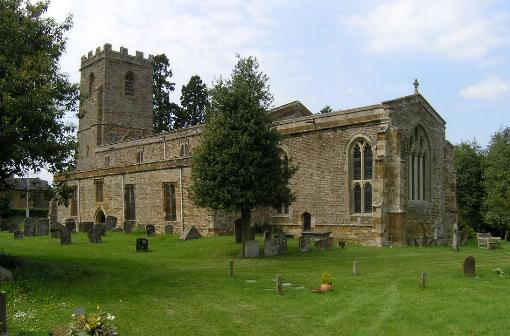 |
a church of many mysteries to me, and one that was exceedingly handsome spacious and well proportioned. Tall Perp west tower, the rest largely Decorated in style. Earlier the south arcade, EE. In the south aisle contrasting stained glass windows, included a handsome paired light of King David and King Solomon (with his temple) which John H reckoned was by Burllison & Grylls, and a very poor window which some of us voted one of the worst we had ever seen (which I forgot to snap it was so bad!). The fine Decorated font has a strange modern cover recalling the openwork spires e.g in East Anglia made out of what seemed to be plywood or MDF at a quick glance. Medieval screens to the north aisle, an unusual Jacobean screen to the tower (with four strange looking figures allegedly female on the top) and some handsome memorials mainly gathered on the walls of the chancel. The mystery concerned the strange weathering of the Easter Sepulchre and Sedilia in the chancel, suggesting this was for long time witthout a roof. Yet the east wall has two very fine image niches in situ with their detailing crisp and undamaged. |
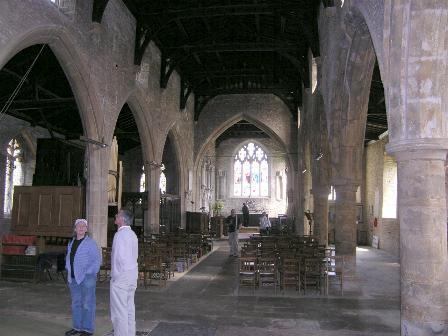 |
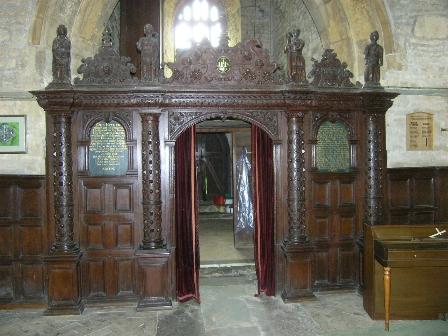 |
Before leaving here John W organised a group photo......he is on the left, Diane, Phil with Marion at his feet, John S, Adrian, John V, John H and RJB on the right.
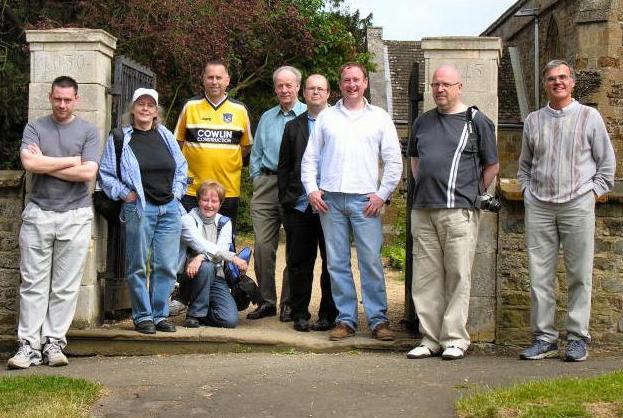
ST MARY, THENFORD, NORTHANTS
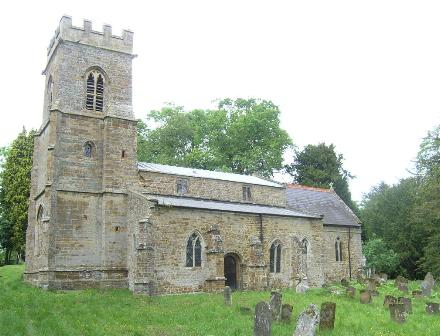 |
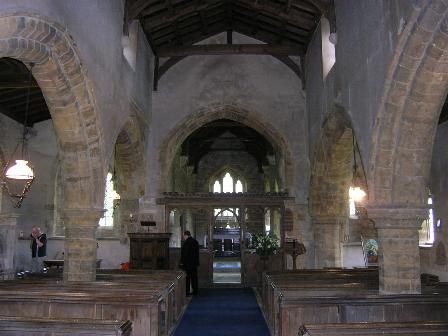 |
We all pulled up on the grass verges in this village and people kept coming out to look at us, one rather threatening youth armed himself with a rake but said nothing. The church is across a field alongside Michael Heseltine's back garden, in which he has a lake and several thousand different trees by the look of it. The church is mainly C14 and C15, not large and with an air of gentle neglect about it, helped by the overgrown back-to-nature churchyard.
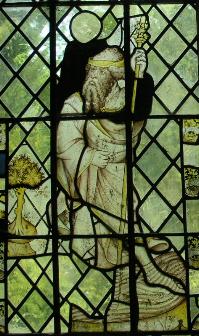 |
By the font a young mum was arranging foliage and flowers on the sills of the two grand windows in the NW corner for her child's christening the following day. Services happen here once a month otherwise. A little east of the doorway is the Elizabethan monument with effigy of Fulk Woodhul d1613. He seems to have been placed a little far up his recess, his head against the respond at one end and leaving a gap between him and the other end, where a carved lion lies. Maybe the sculptor just wanted to show off the sandals on the feet which have unusually been carved with a strap around the sole as if to keep them in place. Big rustic wooden poor box with ironwork. The east window of the north aisle has a St Christopher, not a usual subject for medieval glass. | 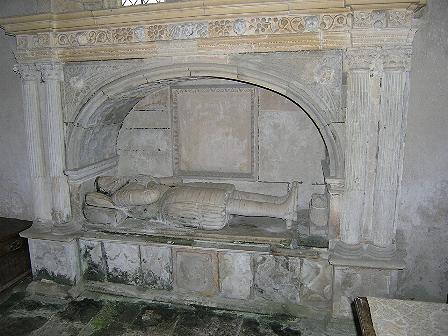 |
ST MICHAEL, FARTHINGHOE, NORTHANTS
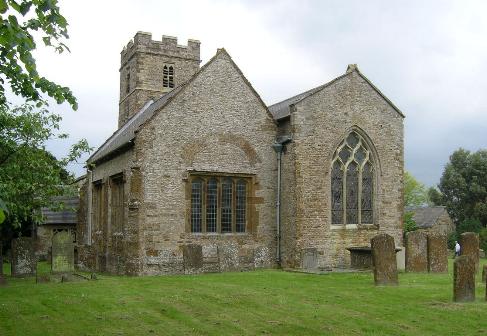 |
After the spaciousness of Marston, this church was tall and quite narrow. Late C12 through to C16, architecturally nothing special. Inside the chancel arch dies into the side walls. The south arcade is the oldest and has one capital with notable stiff leaf decoration. The latest part -the S chapel is much wider and spacious and was used as a school apparently. The west arch was blocked and a monument placed here which is now in two pieces on the floor nearby as a doorway was created in this wall. The best monument is to George Rush d1803 , originally sited further east in the aisle, but probably not liked by the locals who moved close to the entrance and placed it so that he is looking at the wall rather than at them! He is depicted in white marble, on a mattress swathed in cloth wearing his slippers and night cap and looking up from a book he was reading. |
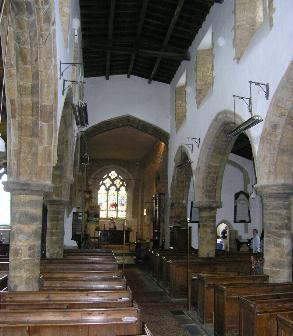 |
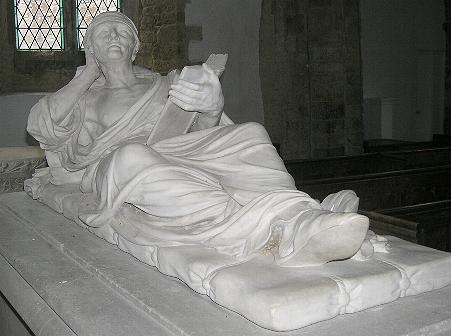 |
The group was beginning to flag and wanted one last highlight so we amended the schedule missing out one church (Newbottle) and proceeded to
SS PETER & PAUL, KINGS SUTTON, NORTHANTS
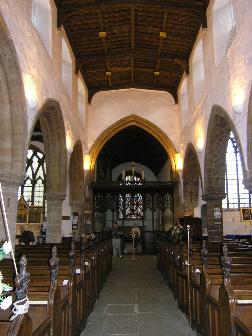 |
with one of the best spires in the county, rising to nearly 200 feet, with very tall flanking angle turrets set back slightly from the parapet and linked to thin angle pinnacles by flying buttresses. Regularly placed crockets give the spire additional splendour. The principle entrance is the west porch, which is vaulted, but the church has north and south porches as well. Sadly the church did not match up to this glory inside and the group was left with a sense of anticlimax - underwhelmed someone said. The church is large and spacious, but much of the original detail has been restored into dullness (such as the blind Norman arcading in the chancel).We did note the astonishingly gruesome memorial in the chancel to Thomas Freke d1769, the skeleton with a gaping hole in its ribcage. Outside the group liked the snoozing dragon atop the corner buttress of the east end of the south aisle. | 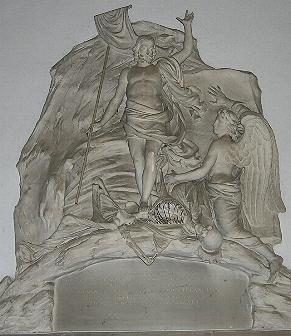 |
ChurchCrawlers gathered outside for a few more minutes to say their goodbyes and cars left the village in all three directions. However I was not yet satisfied and alone I stopped at the large church of
SS PETER & PAUL, DEDDINGTON, OXON
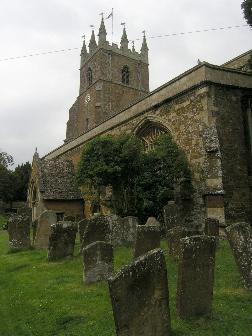 |
The church has a memorable C17 tower, a replacement for one which fell in 1634, due to its eight chunky pinnacles each topped by weather vanes; it was completed after the Civil War unrest 1683-85 and is still Gothic in style. The church itself is otherwise largely C13 and early C14. Inside it was being prepared for a concert and LBP had to tread carefully amongst masses of cabling. A room is also being made by inserting glazed screens in the north-west bay of the aisle. Notable is the domed vault of the north porch. | 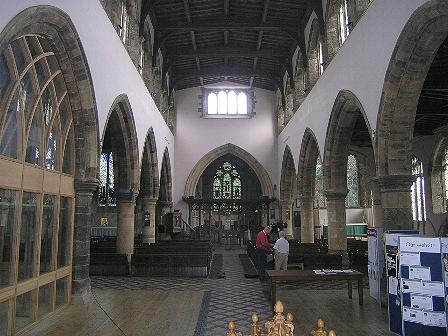 |
ST MICHAEL, GREAT TEW, OXON
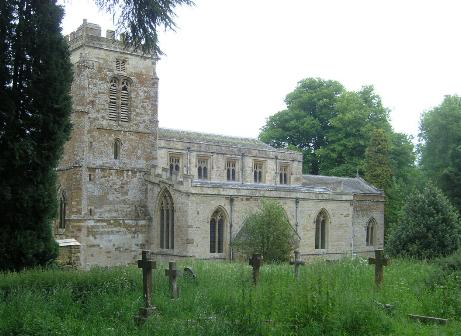 |
is situated some distance from the road where a classical gateway adds grandeur to the start of the path. The churchyard has been allowed to return to nature, and the church itself has an air of controlled neglect, especially inside, and seems to be getting lost in the trees. It is all built on the hillside and from the porch several steps lead down into the church from a Norman doorway which has been embellished by the addition of C14 cusping. | 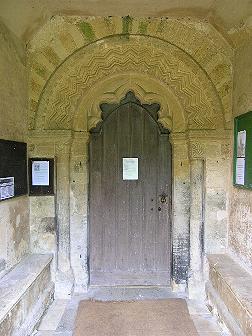 |
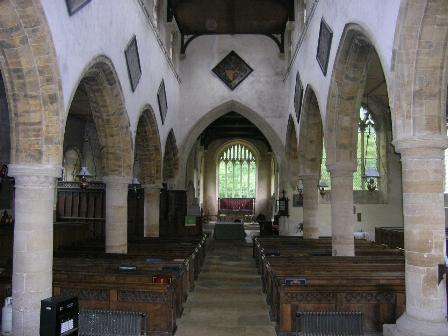 |
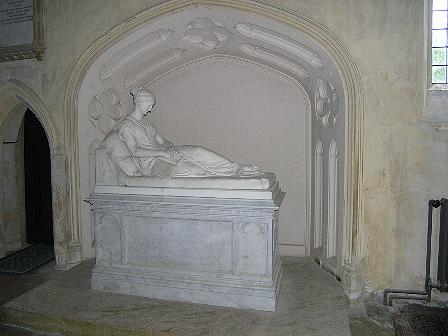 |
The roofs at Great Tew spoil the interior - flat ceilings with only the chancel roof with some ribs and bosses. In the chancel sits Mary Anne Boulton d1829, by Chantrey in white marble, reading a book. Behind the wall has received a panelled Gothick recess. The carpets in the chancel are kept rolled back so that visitors can admire the two near-complete brasses here. Wall paintings have been exposed in the south aisle, a lady lies alone in the north aisle, her husband tucked away in a similar recess in the vestry.
ST JOHN THE EVANGELIST, LITTLE TEW, OXON
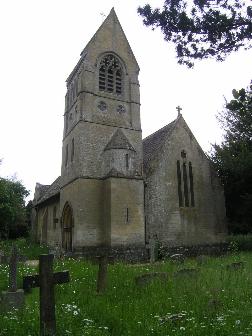 |
was my final church, 1853 by G.E.Street, the tower and north aisle added by Charles Buckeridge in 1869. The tower is the only memorable architectural feature, with a saddleback top and large east and west bell openings. The interior has been whitened and is really of little interest. However the stained glass in the east window was superb to my uneducated eye, unsigned and I needed Mr Hawes there to hazard a guess at the artists, but he was probably well on his way to Birmingham by now. | 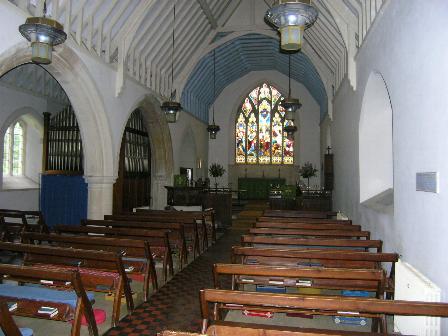 |